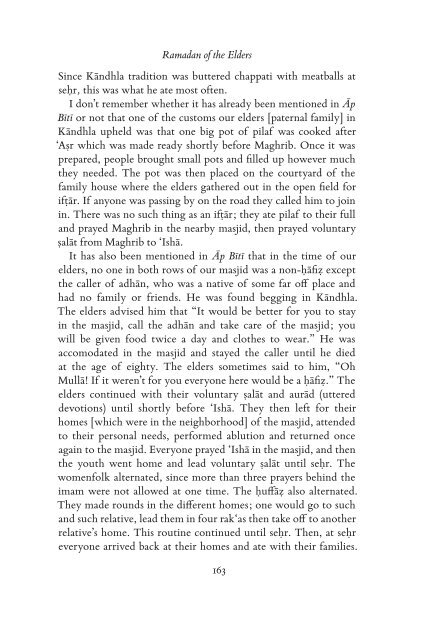TheRamadanOfShaykhAl-hadithMuhammadZakariyyaKandhelviAndOurEldersByShaykhDrMuhammadIsmailMemonMadani
TheRamadanOfShaykhAl-hadithMuhammadZakariyyaKandhelviAndOurEldersByShaykhDrMuhammadIsmailMemonMadani
TheRamadanOfShaykhAl-hadithMuhammadZakariyyaKandhelviAndOurEldersByShaykhDrMuhammadIsmailMemonMadani
You also want an ePaper? Increase the reach of your titles
YUMPU automatically turns print PDFs into web optimized ePapers that Google loves.
Ramadan of the EldersSince Kāndhla tradition was buttered chappati with meatballs atseĥr, this was what he ate most often.I don’t remember whether it has already been mentioned in ĀpBītī or not that one of the customs our elders [paternal family] inKāndhla upheld was that one big pot of pilaf was cooked after‘Aśr which was made ready shortly before Maghrib. Once it wasprepared, people brought small pots and filled up however muchthey needed. The pot was then placed on the courtyard of thefamily house where the elders gathered out in the open field forifţār. If anyone was passing by on the road they called him to joinin. There was no such thing as an ifţār; they ate pilaf to their fulland prayed Maghrib in the nearby masjid, then prayed voluntaryśalāt from Maghrib to ‘Ishā.It has also been mentioned in Āp Bītī that in the time of ourelders, no one in both rows of our masjid was a non-ĥāfiż exceptthe caller of adhān, who was a native of some far off place andhad no family or friends. He was found begging in Kāndhla.The elders advised him that “It would be better for you to stayin the masjid, call the adhān and take care of the masjid; youwill be given food twice a day and clothes to wear.” He wasaccomodated in the masjid and stayed the caller until he diedat the age of eighty. The elders sometimes said to him, “OhMullā! If it weren’t for you everyone here would be a ĥāfiż.” Theelders continued with their voluntary śalāt and aurād (uttereddevotions) until shortly before ‘Ishā. They then left for theirhomes [which were in the neighborhood] of the masjid, attendedto their personal needs, performed ablution and returned onceagain to the masjid. Everyone prayed ‘Ishā in the masjid, and thenthe youth went home and lead voluntary śalāt until seĥr. Thewomenfolk alternated, since more than three prayers behind theimam were not allowed at one time. The ĥuffāż also alternated.They made rounds in the different homes; one would go to suchand such relative, lead them in four rak‘as then take off to anotherrelative’s home. This routine continued until seĥr. Then, at seĥreveryone arrived back at their homes and ate with their families.163


